Wild About Texas – September, 2009
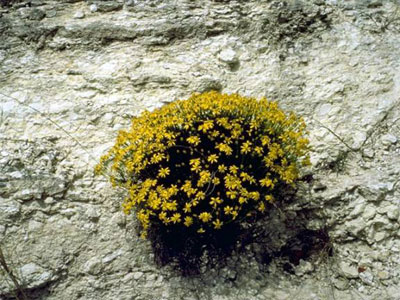
Damianita. (Check out that soil!) Photo by Paul Cox.
Right Plant in the Right Place
You can never have too much compost and organic matter in your garden soil, right? Well … usually, but not always. Some native plants are labeled “finicky” when, in fact, they would be just fine if they were grown in the right conditions. (To be honest, though, some plants really are just finicky). Here is an explanation I hope will help you ultimately be more successful in your gardening experiments, and isn’t all gardening just a series of experiments?
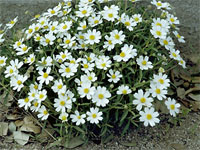
Blackfoot daisy.
Photo by Mrs. W. D. Bransford.
Some natives such as blackfoot daisy (Melampodium leucanthum) or damianita (Chrysactinia mexicana) are found in the wild happily growing in what most gardeners would NOT consider “soil.” The dirt may be nothing more than a lean layer of caliche on top of a limestone shelf. Sometimes these sites are on a slope where water runs off more than soaks in and the soil may not contain much organic matter. All of this results typically in lesser-sized plants.
These small, often slow, growers (in the wild anyway) do not represent much biomass and therefore do not contribute large amounts of organic matter to the soil as they decompose. It makes sense that plants adapted to these conditions would not necessarily be accustomed to heavily composted garden beds.
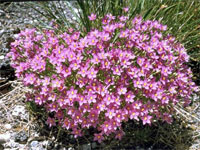
Mountain pink.
Photo by Norman Flaigg.
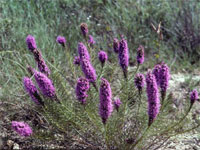
Gayfeather. Photo by Sally and Andy Wasowski.
In a fertile, rich, well-watered garden, I’ve found blackfoot daisies, four-nerve daisies and, of course, many cacti tend to rot, especially during rainy spells in summer. Plants may grow lush and be covered with flowers for a while, only to steam cook into a wilted black pile of sour vegetation. The coveted mountain pinks (Centaurium beyrichii) run into problems if grown in conditions that promote larger plants that get “pushy” and overcome the more delicate species. Others such as gayfeather (Liatris spp.) may survive but grow leggy, almost vine-like, and unattractive. Incidentally, mineral mulches such as pea gravel, crushed limestone or decomposed granite wick away moisture from the bases of plants and lower humidity, which can help reduce fungal diseases.
Since plants in the legume family produce their own food from the sun and fix nitrogen from the air, they often prefer poor substrates. For example, Texas bluebonnets respond to rich and fertile soils by over-producing foliage and under-producing flowers. They may succumb to powdery mildew and get leggy. We frequently find more bluebonnets growing in the crushed granite paths at Lady Bird Johnson Wildflower Center than in the prepared flower beds!
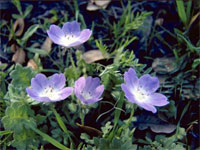
Baby blue-eyes.
Photo by Mrs. W. D. Bransford.
Conversely, woodland plants such as golden groundsel (Packera obovata), pecan (Carya illinoinensis) or baby blue eyes (Nemophila phacelioides) are often found in deeper soils supporting denser vegetation, which in turn contributes more organic matter to the soils. Generally speaking, woodlands have richer soils. Rivers and creeks can be spotted by the presence of trees, and the same concept of biomass turning into organic matter applies here, too, just with more moisture added. Woodland plants like compost and may prefer extra dampness or dry shade, depending on the species.
Putting these ideas into practice, you would be wise to add more organic matter to shade-loving plants and to do a little more research (and less work) when planting hard-core caliche lovers. Whereas most native species would appreciate or at least tolerate more organics, you may be able to save yourself a lot of labor and expense if you don’t find the need to work in soil additives.
For more information about Texas native plants, visit the Wildflower Center’s website at: www.wildflower.org.
About the author: Andrea DeLong-Amaya is the director of horticulture at the Lady Bird Johnson Wildflower Center in Austin.
